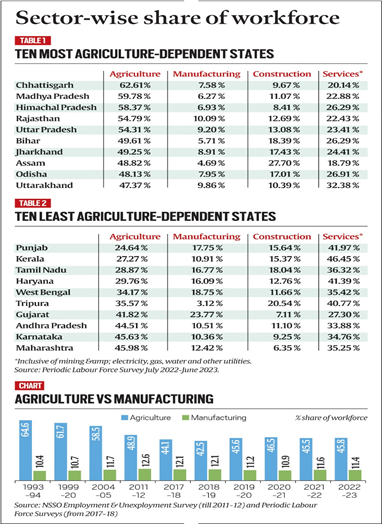

30th October 2023 (11 Topics)
Context:
India's labor dynamics are deviating from Lewis' model. Rethinking economic strategies for job creation in and around agriculture is essential.
What is the Lewis Model of Structural Economic Growth and Development?
- Arthur Lewis put forward a development model of a dualistic economy, consisting of ‘Rural agricultural and urban manufacturing sectors’.
- Initially, the majority of labour is employed upon the land, which is a fixed resource. Labour is a variable resource and, as more labour is put to work on the land, diminishing marginal returns eventually set in:
- There may be insufficient tasks for the marginal worker to undertake, resulting in reduced marginal product (output produced by an additional worker) and underemployment.
- Urban workers, engaged in manufacturing, tend to produce a higher value of output than their agricultural counterparts.
- The resultant higher urban wages (Lewis stated that a 30% premium was required) might therefore tempt surplus agricultural workers to migrate to cities and engage in manufacturing activity.
- High urban profits would encourage firms to expand and hence result in further rural-urban migration.
- The Lewis model is a ‘model of Structural Change’ since it outlines the development from a traditional economy to an industrialized one.
Lewis' Model and India's Reality:
- William Arthur Lewis' model envisioned surplus farm labor shifting to manufacturing for economic growth.
- India's experience deviates to agriculture's share fell but manufacturing's rise was marginal from 1993-94 to 2011-12.
- Recent trends show a return to higher farm employment due to pandemic impacts, while manufacturing's share drops.

Structural Transformation Challenges:
- Shift from "subsistence" to "capitalist" sectors falters; labor movement mainly within subsistence sectors.
- New jobs created outside agriculture are often low-paid, in services, and construction, not high-productivity industries.
- Gujarat stands out, resembling Lewis' model, but still has a significant agricultural workforce.
Emerging Labor Challenges:
- Traditional manufacturing sees automation, making labor transitions more complex.
- NITI Aayog proposes a new economic model focusing on job creation related to agriculture.
- This model involves activities beyond farming, like processing, retailing, and supplying services to farmers.


